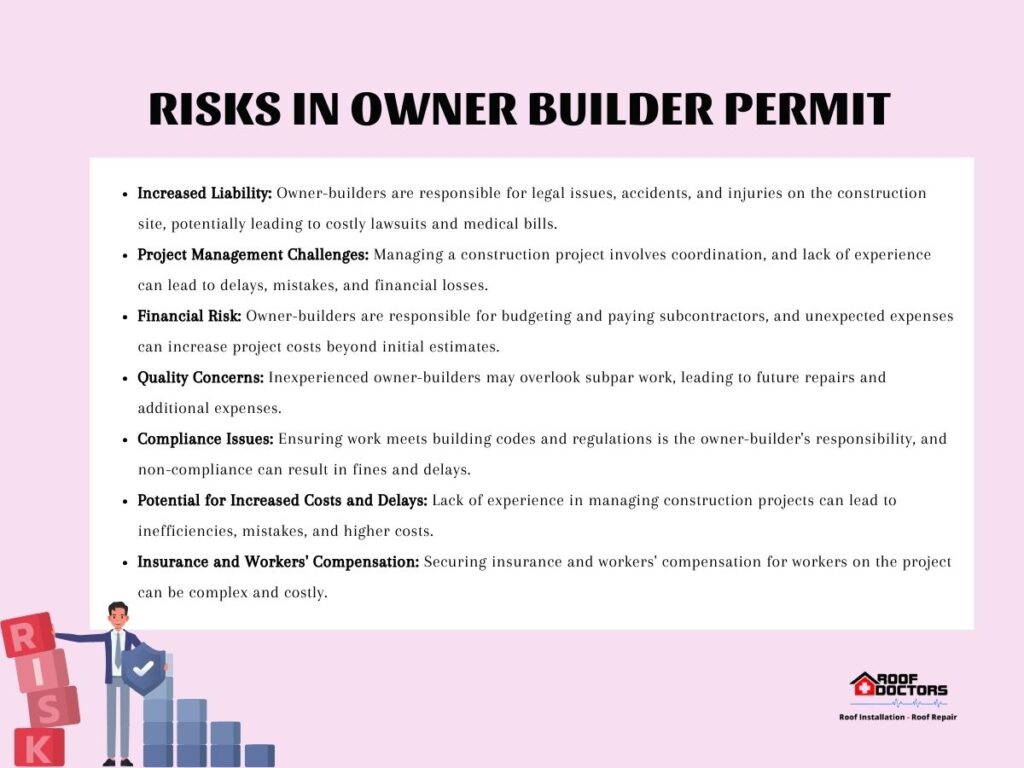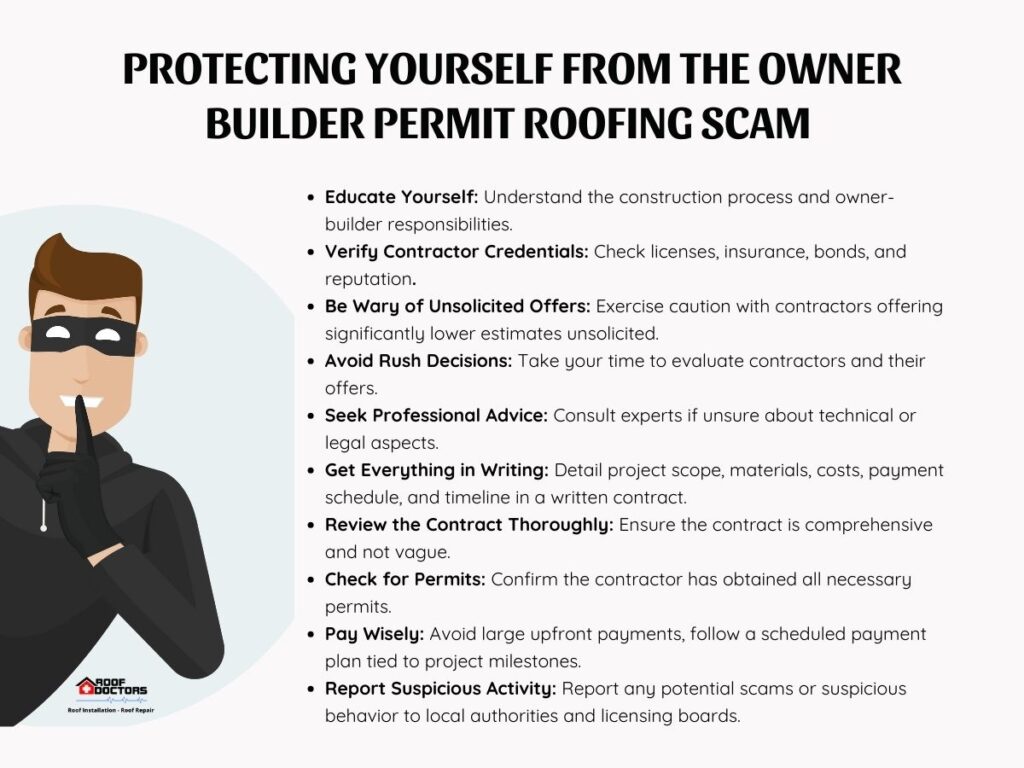In the beautiful state of California, where dream homes are often constructed under the golden sun, many homeowners fall victim to a fraudulent scheme known as the Owner Builder Permit Roofing Scam.
This scheme involves unethical contractors coaxing homeowners to apply for Owner Builder Permits, unwittingly leaving them burdened with liabilities, insurance responsibilities, and adherence to building codes. This cunning ruse allows contractors to evade these duties, potentially leading to substandard, non-compliant work at the homeowner’s expense and peril.
This detailed guide intends to educate homeowners about this scam, providing insights into how it operates and its consequences and offering practical advice on protecting oneself from falling into this insidious trap.
What Does Owner Builder Mean?
An “Owner Builder” is a homeowner who acts as the general contractor for construction projects on their property, taking on responsibilities like obtaining permits, hiring and supervising subcontractors, overseeing inspections, managing the budget, and ensuring compliance with all building codes and regulations.
While this role can potentially save money, it comes with significant risks. Owner-builders assume all liability for the project, including accidents, injuries, and compliance with building codes. Mistakes or oversights can lead to costly repairs, penalties, or legal issues.
It’s crucial for those considering this route to have a comprehensive understanding of the construction process and local regulations to manage the responsibilities and risks involved effectively.
What is an Owner Builder Permit?
An Owner Builder Permit allows homeowners to act as their general contractor for construction projects. This role includes responsibilities like obtaining all relevant permits, hiring and managing subcontractors, ensuring compliance with building codes, scheduling inspections, and assuming liability for the project.
While this permit can save the cost of a general contractor, it also exposes the homeowner to increased legal and financial risks. Homeowners are liable for any accidents, injuries, or non-compliance issues during the project, making it crucial to consider their readiness to manage these aspects before obtaining the permit.
Understanding the Scam: An Overview
The Owner Builder Permit Roofing Scam in California begins when a contractor approaches a homeowner with an offer to perform roofing work at an irresistibly low price. The catch? The homeowner must obtain an Owner Builder Permit, effectively assuming the role of general contractor for the project.
While this might initially seem like a bureaucratic detail, it has serious implications. Obtaining this permit shifts legal and financial responsibility from the contractor to the homeowner. In the case of accidents, faulty work, or other issues, the homeowner bears the liability, leaving them vulnerable to financial and legal repercussions.
The Risks Involved
The risks involved in obtaining an Owner Builder Permit and acting as your general contractor include:

1. Increased Liability:
As an owner-builder, you are responsible for all aspects of the project, including adherence to building codes and safety regulations. Any legal issues, accidents, or injuries on the construction site become your liability, potentially leading to costly lawsuits or medical bills.
2. Project Management Challenges:
Managing a construction project involves coordinating various tasks, subcontractors, and schedules. Without experience, it’s easy to get overwhelmed, leading to delays, mistakes, and potential financial losses.
3. Financial Risk:
You are responsible for the project’s financial management, including budgeting and paying subcontractors. Unexpected expenses can arise, and without a fixed contract price, the final cost may exceed initial estimates.
4. Quality Concerns:
Lack of expertise in construction may result in oversight of subpar work, leading to future repairs and additional expenses. Ensuring quality workmanship and materials is essential to prevent these issues.
5. Compliance Issues:
Ensuring all work meets local building codes and regulations is your responsibility. Non-compliance can result in fines, delays, and redoing work costs.
6. Potential for Increased Costs and Delays:
Without experience in managing construction projects, you may face delays and increased costs due to mistakes, inefficiencies, and lack of knowledge in procuring materials and services at optimal prices.
7. Insurance and Workers’ Compensation:
Securing adequate insurance and workers’ compensation for the workers on the project is your responsibility, which can be a complex and costly process.
Considering these substantial risks, it’s crucial to carefully assess your capabilities, resources, and tolerance for risk before deciding to obtain an Owner Builder Permit. Consult with legal and construction professionals to fully understand the implications and responsibilities is often advisable.
Recognizing the Scam: Red Flags to Look Out For
Recognizing a scam involving the misuse of an Owner Builder Permit is essential for protecting yourself from financial and legal repercussions. Here are some red flags to be aware of:
1. Unsolicited Offers:
Be cautious of contractors who approach you unsolicited with roofing or other construction work offers. Scammers often use this tactic to find victims.
2. Pressure to Obtain an Owner Builder Permit:
A significant red flag is when a contractor pushes you to obtain an Owner Builder Permit. They may downplay the responsibilities and risks involved and highlight the cost savings. This pressure tactic should raise alarms as legitimate contractors typically handle permits themselves.
3. Too-Good-to-Be-True Pricing:
Extremely low bids or offers that seem too good to be true often are. Scammers use low prices to lure victims, but the final costs may balloon, or the work may be subpar.
4. Lack of License and Insurance Information:
Contractors unwilling or unable to provide valid licensing and insurance information are likely not legitimate. Ensure to verify this information independently.
5. Evasive or Unclear Answers:
Be wary of contractors who avoid answering questions directly, give unclear answers, or are unwilling to provide detailed written estimates and contracts.
6. Requests for Large Upfront Payments:
Suspicion should arise if a contractor requests a significant upfront or cash payment. A standard down payment should not exceed a certain percentage of the total project cost.
7. No Physical Business Location:
Check if the contractor has a physical business address. The lack of a verifiable location is a potential indicator of a scam.
By staying vigilant and recognizing these red flags, you can protect yourself from falling victim to scams involving the misuse of Owner Builder Permits and ensure your construction project proceeds smoothly and legitimately.
Protecting Yourself from the Owner Builder Permit Roofing Scam
Navigating the world of home renovations and repairs can be tricky, especially with the emergence of scams like the Owner Builder Permit Roofing Scam in California. Protecting yourself from falling victim to such scams is crucial.
Below are comprehensive steps and tips on how to ensure you and your property remain safe and secure:

1. Educate Yourself:
Familiarize yourself with the construction process, including the roles and responsibilities of an owner-builder. Knowing what an Owner Builder Permit entails can help you understand the risks involved.
2. Verify Contractor Credentials:
Before hiring a contractor, verify their license, insurance, and bond information. Check their reputation through online reviews and ask for references to ensure their credibility.
3. Be Wary of Unsolicited Offers:
Exercise caution when dealing with contractors who approach you with unsolicited offers, especially those providing significantly lower estimates than others.
4. Avoid Rush Decisions:
Don’t succumb to pressure from contractors urging immediate decisions. Take your time to evaluate the contractor and their offer thoroughly.
5. Seek Professional Advice:
If you’re unsure about the technical aspects or legalities involved in your project, don’t hesitate to consult a lawyer or a knowledgeable professional in the construction industry.
6. Get Everything in Writing:
Ensure all aspects of the project, including the scope of work, materials, costs, payment schedule, and completion timeline, are detailed in a written contract.
7. Review the Contract Thoroughly:
Carefully review the contract, ensuring it includes all discussed and agreed-upon aspects. Avoid signing incomplete or vague contracts.
8. Check for Permits:
Confirm that the contractor has obtained all the necessary permits for the project. Be cautious if they ask you to get the permits, as this could be a sign of the Owner Builder Permit scam.
9. Pay Wisely:
Avoid making large upfront payments. Adhere to a scheduled payment plan aligned with the completion of specific project milestones.
10. Report Suspicious Activity:
If you encounter any suspicious behavior or potential scam activity, report it to local authorities and the Contractors State License Board.
Ensuring diligent and cautious dealings with contractors and understanding the intricacies involved in construction projects will contribute to the smooth, secure, and successful completion of your home renovation or repair projects.
Conclusion
In the face of the Owner Builder Permit Roofing Scam in California, homeowners’ awareness and vigilance are paramount. This scam exploits homeowners’ unfamiliarity with construction and permitting processes.
Homeowners must recognize the signs of this deceptive practice, such as unsolicited offers, pressure to acquire permits, and suspiciously low project estimates. Proactively verifying contractor credentials, obtaining detailed written contracts, and consulting with legal and construction professionals are essential to safeguarding against potential scams.
Thorough understanding and diligence provide a robust defense, ensuring construction projects’ smooth and secure progression. By taking these precautions, homeowners can confidently navigate their renovation journeys, ensuring their projects are completed successfully and their financial and legal rights are protected.


